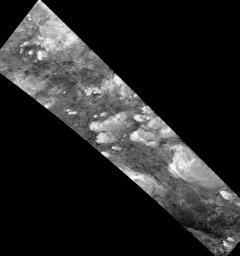
|
Flowing Dunes of Shangri-La (Denoised)
- Click the image above for a larger view
- Full-Res JPEG (1920 x 2048) (338.2 kB)
- Full-Res TIFF (1920 x 2048) (1.6 MB)
Caption:
This radar image of the Shangri-La Sand Sea on Titan from NASA's Cassini spacecraft was produced using the same radar data as PIA20710 , but shows a larger area of Titan's surface. This version includes terrain to the northwest and southeast of the other version. Here, the radar data have been treated with a technique for handling noise that can result in clearer, easier to interpret views (see also PIA19053 ).
Hundreds of sand dunes are visible as dark lines snaking across the surface. These dunes display patterns of undulation and divergence around elevated mountains (which appear bright to the radar), thereby showing the direction of wind and sand transport on the surface.
Sands being carried from left to right (west to east) cannot surmount the tallest obstacles; instead, they are directed through chutes and canyons between the tall features, evident in thin, blade-like, isolated dunes between bright some features. Once sands have passed around the obstacles, they resume their downwind course, at first collecting into small, patchy dunes and then organizing into larger, more pervasive linear forms, before being halted once again by obstacles.
These patterns reveal the effects not only of wind -- perhaps even modern winds if the dunes are actively moving today -- but also the effects of underlying bedrock and surrounding topography.
Dunes across the solar system aid in our understanding of underlying topography, winds and climate, past and present. Similar patterns can be seen in dunes of the Great Sandy Desert in Australia, where dunes undulate broadly across the uneven terrain and are halted at the margins of sand-trapping lakes. The dune orientations correlate generally with the direction of current trade winds, and reveal that winds must have been similar back when the dunes formed, during the Pleistocene glacial and interglacial periods.
The image was taken by the Cassini Synthetic Aperture radar (SAR) on July 25, 2016 during the mission's 122nd targeted Titan encounter. The image has been modified by the denoising method described in A. Lucas, JGR:Planets (2014).
Background Info:
The Cassini-Huygens mission is a cooperative project of NASA, ESA (the European Space Agency) and the Italian Space Agency. NASA's Jet Propulsion Laboratory, a division of the California Institute of Technology in Pasadena, manages the mission for NASA's Science Mission Directorate, Washington. The Cassini orbiter was designed, developed and assembled at JPL. The radar instrument was built by JPL and the Italian Space Agency, working with team members from the United States and several European countries.
For more information about the Cassini-Huygens mission visit http://saturn.jpl.nasa.gov and http://www.nasa.gov/cassini .
Cataloging Keywords:
| Name | Value | Additional Values |
|---|---|---|
| Target | Titan | |
| System | Saturn | |
| Target Type | Satellite | |
| Mission | Cassini-Huygens | |
| Instrument Host | Cassini Orbiter | |
| Host Type | Orbiter | |
| Instrument | Radar Mapper | |
| Detector | ||
| Extra Keywords | Dune, Grayscale, Mountain, Radar | |
| Acquisition Date | ||
| Release Date | 2016-09-07 | |
| Date in Caption | 2016-07-25 | |
| Image Credit | NASA/JPL-Caltech/ASI/Universite Paris-Diderot | |
| Source | photojournal.jpl.nasa.gov/catalog/PIA20711 | |
| Identifier | PIA20711 | |
